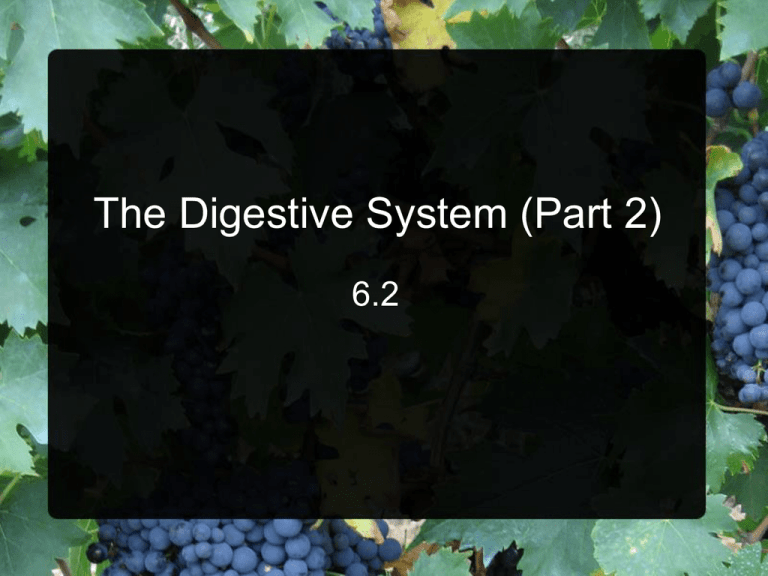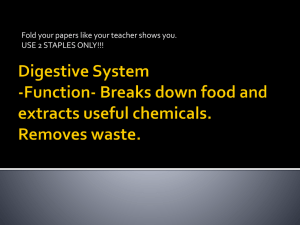File
advertisement

The Digestive System (Part 2) 6.2 Small Intestine Longest part of digestive tract Some physical digestion through segmentation Chyme sloshes back and forth between segments as circular muscles briefly contract Main function Complete digestion of macromolecules and absorb the subunits Structures of the Small Intestine 3 regions: Duodenum – 25 cm Jejunum – 2.5 m Ileum – 3 m Ducts in the Small Intestine Ducts from the liver gallbladder and pancreas join in one duct that enters the duodenum Max Surface Area = Max Absobtion Folds in the lining of the intestine are covered with millions of villi Villi are covered with millions of microscopic microvilli The Jejunum (middle) & Ileum (end) Jejunum has more folds than duodenum Continues the breakdown of food Ileum has fewer, smaller villi main purpose is absorption, and pushing remaining undigested food toward the large intestine Accessory Organs Enzymes are secreted from microvilli of the small intestine to help digest materials in chyme Substances secreted from 3 organs near the stomach & small intestines also help digestion Accessory organs Vital to digestive process, but not physically part of the digestive tract Accessory Organs: Pancreas 1 L of pancreatic fluid/day Contains many enzymes Trypsin & chymotrypsin proteases that digest proteins Pancreatic amylase carbohydrase that digests starch Lipase digests fat Accessory Organs: Pancreas Breaks nutrients down into small enough molecules to be digested and absorbed by small intestine Also contains bicarbonate to neutralize the HCl from the stomach (resulting pH 8) Accessory Organs: Liver Largest internal organ Suspend smaller fat molecules in water, provide greater surface area for lipases to attack, so digestion occurs more quickly The Liver Secretes bile Bile pigments no digestive function; old red blood cells, eliminated through feces Bile salts assist in fat digestion; they are emulsifiers Accessory Organs: Gall Bladder Stores bile between meals Chyme that contains fat stimulates the gall bladder to contract Bile travels from the gall bladder to the duodenum via a duct shared with the liver Digestion and Absorption in the Small Intestine Enzymatic Digestion is performed by Carbohydrases Lipases Proteases Nucleases Note P 225, Fig. 6.21 and Table 6.3 Regulation of Processes in the Small Intestine Regulated by nervous system and endocrine system Chemical signals from food nervous system salivary & gastric secretions Stomach Acid & Negative Feedback Proteins in stomach gastrin HCl & pepsin Lowered pH inhibits further secretion of gastrin, therefore no more HCl & pepsin secreted (negative feedback) Gastrin Released Somatostatin Release CGRP (a protein) Increased gastric juices Lower pH (Acid) Controlling the Stomach Passage of chyme from stomach to duodenum inhibits stomach contractions through secretions of Secretin released when chyme has high acidity; stimulates pancreas to release more bicarbonate CCK (cholecystokinin) Released when chyme has high fat content; stimulates increased pancreatic & gall bladder secretions GIP (gastric inhibitory peptide) Released when chyme has a high fat content; allows fatty meals to remain in stomach longer than non-fatty meals The Large Intestine Main function: Concentrate and eliminate waste materials (500 mL of indigestible residue is reduced to 150 mL of feces) Absorb water and salts









